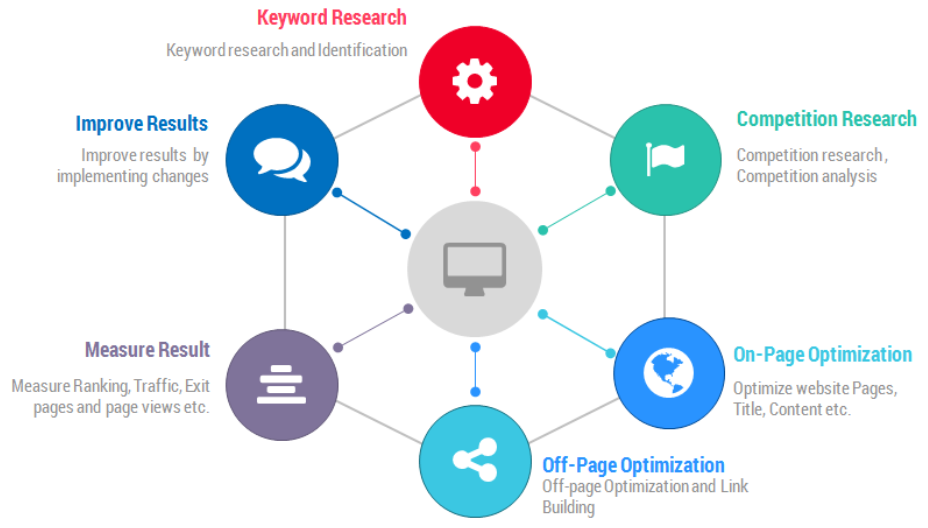Are you failing to plan or planning to fail? An SEO strategy gives you a blueprint that you can measure your SEO activities from, helping you see the bigger picture. Here we discuss some important stages of an SEO strategy. We also offer strategic support with our SEO Services if you don’t have the time or resources.
What is an SEO strategy or plan?
An SEO strategy / plan is a blueprint for your Search Engine Optimization activities. It is a long-term solution to drive pre-qualified traffic to your website, improve conversion rates and boost your online revenue. Although SEO is considered more of a medium to long-term strategy, a well-executed SEO strategy can influence positive visibility changes within the first few months (dependent on the industry and targets).

Looking for help with creating an SEO Strategy or SEO Plan? Get in touch
Initial Analysis
The first step of an SEO strategy is to complete a thorough analysis of the website and its competition. During an analysis (or when it is a top-to-bottom analysis with a reporting component, an SEO audit) the consultant can see first-hand the strengths and weaknesses of the current technical infrastructure of the site, what keywords have been targeted previously, the on-page content, the link building profile and competitor analysis. It is essential that clients are straightforward with optimization experts about techniques they have used in the past.
During this process, the SEO consultant will look at considerations such as:
- Site structure and page trees
- Internal and external linking
- Inbound links or “backlinks”
- Metadata, including meta titles and meta descriptions
- Header tags (H1, H2, H3, etc.)
- Content length and quality
- Content update frequency
- Infrastructure files and code, including scripts, tracking codes, redirects, robots.txt, sitemap.xml, and more
- Competitor data (including an analysis of the above for competition)
Analysis and Recommendations
Based on the initial analysis, an SEO consultant identifies specific deficiencies on the site, as well as opportunities for targeting new search traffic, and prepares a report for a search engine optimization campaign. This report will include recommendations for both on-site and off-site tactics that will support the overarching SEO strategy.
The SEO will provide these recommendations to you so that you can begin optimizing your website, or the SEO can implement recommendations herself (often with the assistance of a qualified web developer). A professional company ideally will offer SEO solutions tailored to your individual circumstance. This will depend on factors such as the size of the site if it is operating in a competitive or saturated market, whether it is a new website, is focusing on growth or ongoing maintenance and so on.
Keyword Research
Typically, the number of keywords targeted depends on the size and scope of the SEO project. Once an SEO strategy plan has been mapped out, the analyst will have a better idea of the number of keywords. A plan can be developed for how those keywords fit in with optimized pages and link submissions necessary to make progress in the SERPs. Analysts start by researching keywords and coming up with a shortlist that both the agency and client are happy with. This may include several research methods including keyword recommendations from the client, customers and suppliers, surveys, using keyword research tools and so forth.
Keywords also vary widely in search intent and length. Short-tail keywords like “Indian restaurant” may have a large search volume, whereas long-tail keywords such as “Indian restaurant serving breakfast in Philadelphia” will have a lesser search volume. The SEO analyst’s job is to strike a balance between types of keywords and the amount of search volume behind them.
SEO Implementation
This is the exciting part of SEO strategy plans. The agreed changes to your website are implemented on your pages either directly by your consultancy if you have a content management system (CMS) or they will liaise with your web developer for them to code the changes required. The off-page optimization including link building and options such as optimizing Google Places pages is also done at this critical stage. This is the core of an SEO strategy – the on-the-ground work that helps to increase your site’s visibility in search engines.
Tweaking your technical infrastructure
You can take baby steps to improve the technical infrastructure of your website, such as fixing broken links and optimising images to make your site faster. You can also make major changes, such as changing your hosting company or planning to improve site speed. Analysis of your website’s technical infrastructure includes looking at the quality of coding, the hosting environment and speed of the site, the IP address, robots.txt file, sitemap structure and URL/filename naming.
Fine-tuning your on-page optimization
With all the hype about Google’s latest algorithm updates, it is easy to forget about the basics that are needed to get high rankings. This includes on-page optimization such as your title tags, meta description tags, headings, body copy, anchor text and ALT (alternative) text for images. Ideally, each web page should target a particular keyword – this helps search engines understand what the page is all about and index it accordingly.
Reporting
During your campaign, you should be given progress reports by the SEO expert you have hired. Bear in mind that Search Engine Optimization is a long-term strategy, and you will not be able to see results straight away. As a rule of thumb, agencies will provide clients with monthly reports. Communication is recommended throughout the process, but this is your opportunity to ask any questions about the campaign or tweak it slightly. Typically, the results of an SEO campaign can take anywhere from 3 months to a year before showing up in reporting.
Ongoing Maintenance
Once you are happily ranking on search engines, you will need to discuss with the experts at your SEO consultancy whether you should expand your keyword portfolio and target more keywords or choose to maintain the optimization of your site. This will depend again on factors such as how many pages your website has, the competition in your industry, the traffic driven to your site, your conversion rate and so on.
Typically, others in the industry will be maintaining ongoing SEO on their sites, so it’s usually advisable to continue monitoring, tweaking, and expanding your SEO strategy as time goes on. The logic is that if you’re not acting on your own search visibility, but your competitors are, it’s likely that you’ll eventually lose any hard-earned progress in search engine rankings.
Freshening up your keywords
As search evolves, so should the keywords that your target market uses to look for companies such as yours on the web. Your keyword strategy may have been current and on-point a few years ago, but it can quickly become outdated. Make sure your keywords are refreshed every six months and don’t forget to take into account seasonal trends. You may also want to expand your keyword portfolio. Keyword research tools include:
- Premium tools such as WordTracker and Keyword Discovery
- Free tools such as Google Keyword Research Tool
- Surveying clients, customers, and suppliers
- Analysing social media chat
- Asking clients for a list of keywords relevant to their business
- Google Analytics and other web analytics tools
- Focus groups and usability tests
- Competitor analysis
- Thesaurus to find synonyms for keywords for SEO strategies.
Revisiting link-building campaigns
A link audit is necessary at least every year to see whether you are within the search engine’s guidelines, especially in light of Google algorithm changes like Google Panda, and whether there are weaknesses or gaps in your link-building campaigns. Check if you have any inbound links that may be damaging to your site’s rankings, as well as look for new link-building opportunities such as new directories or subject-specific blogs or online media that have sprung up.
Reworking your online copy
Every business should revamp its website content regularly and undertake an end-to-end review every year. Check whether the content on your site is still current and accurate and whether there is duplicated content which needs to be rewritten or updated. If there is duplicated content which needs to be rewritten and whether there are more opportunities to add content such as a company blog or a news and views page. In some cases, you may also have to de-optimize your copy by reducing keyword frequency and evaluating the use of keywords and anchor text in your internal linking.
Reviewing SEO Plan
SEO plans need to be somewhat flexible and require regular reviews to ensure that optimizations are proving effective and targets are being met. If you are operating in an industry that is very competitive, it’s important to consider the efforts of competing websites and what may be required to outrank them in the SERPs (Search Engine Results Pages). An SEO specialist should monitor changes and trends in the industry to ensure your SEO strategy can continually be innovated.
Need help with your SEO strategy?
At The SEO Works, we provide SEO services suitable for small-medium companies through to large corporate enterprises that are customized to each individual business. Get in touch with us to find out more about our SEO expertise and how we can create a bespoke SEO strategy to suit your present and future needs.




